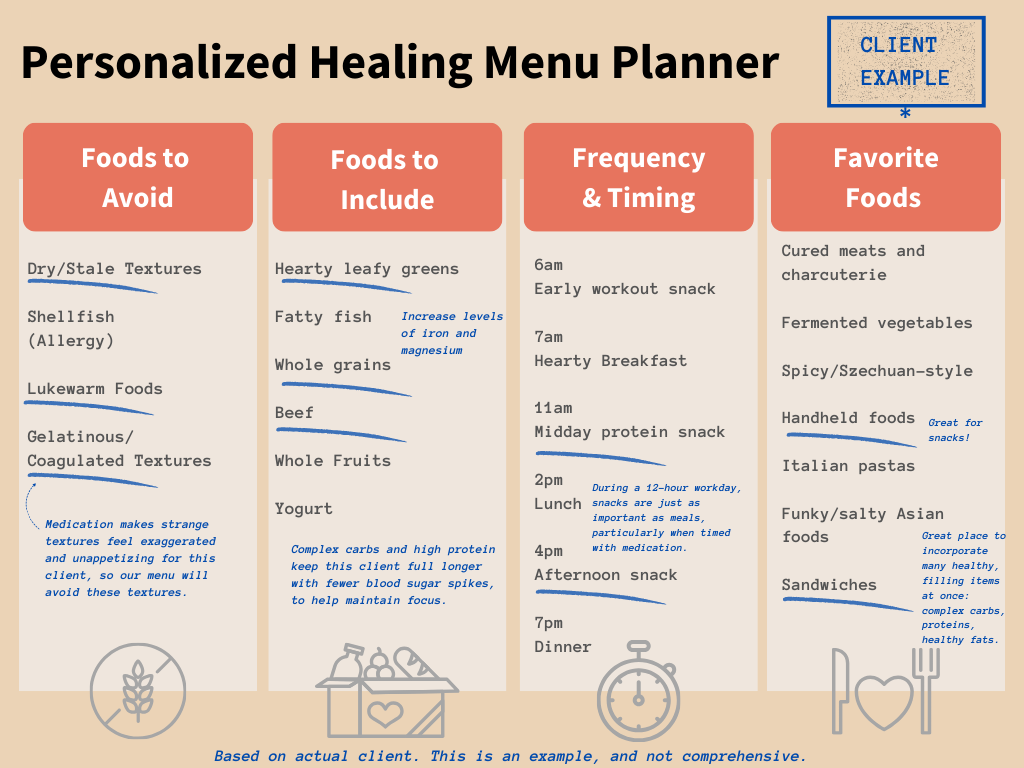Happy Thursday, health heroes.
Today’s article is a guest post from one of our Core 4 specialists and team members at Health Shift, Erin Tarectecan. I’m so excited to have her share her wealth of knowledge with you. She is a chef, prize-winning barista, Precision Nutrition Coach, and an all-around ninja and a force to be reckoned with, as well as one of my best friends and my daughter! Yup - she’s my second brain!
As you know, nutrition plays a key role in healing — and she can make nutritious, delicious food tailored to positively impact any health condition. That’s right - she makes meals that heal!
You can find more about her work here. My article below provides a quick refresher on Core 4. But keep reading—Erin’s ready to tell you about the kitchen cure.
Hi! It’s Erin Tarectecan. I’ve worked in the food service industry for over 10 years alongside some tough chefs and stood my ground. Now, I champion the industry, empowering its employees with encouragement and support. I also help people heal with food, addressing the nutrition aspect of the Core 4.
I'm here to introduce the concept of meals that heal, and it all starts with you. You are a unique cocktail of physical ingredients, experiences, genetics, and environment, and I think your healing journey should reflect that uniqueness. Our bodies respond to treatments, medicines, and medical stress in highly individual ways, but each individual body also reacts uniquely to food. That’s an article in and of itself that I’ll write sometime soon, so stay tuned.
But whether you struggle with a chronic illness, a nagging health concern, or a painful short-term condition, I can assure you that there is a solution that can be tailored to you through food. Again, one of the most foundational ways to heal is through food.
For most people, the first step in finding a solution is turning to the Internet, typing symptoms into a search bar, and sifting through information. But rarely does Google give you insights into how to heal through food. It misses an actionable understanding of how to nourish our bodies for healing.
Of course, we all know Google is full of repetitive generic health advice: eat your veggies and fruits, stay away from sugar, etc. While these are important pillars of eating well, healing is possible through food, and I don’t see much written about that.
But healing through food isn’t about eating "healthy." It’s about eating what’s right for you.
Why Food Matters in Healing
Food is a necessity but also has a direct link to our health. Every bite fuels our body with the vitamins, minerals, and compounds needed to function optimally. It affects our mood, mental clarity, immune system, digestive health, weight, and even our risk of chronic disease. When we’re ill or recovering, nutrition becomes even more crucial—it can be the key to accelerating healing, helping medications be more effective, and reducing symptoms.
Food is also mental, emotional, and spiritual. At the intersection of these dimensions, I do my best work, creating delicious meals that heal uniquely in response to each individual’s needs. I consider food as an opportunity to induce spiritual nourishment, emotional joy, and mental clarity. I highly encourage people to cook (even if it’s easy cooking), to experience the smells and wonder of the experience (trust me, you can do it!). I think enjoying food with others can also be a healing experience if done in the right setting (no, I’m not talking about eating pizza and watching the Superbowl).
The Personalized Healing Menu
Enter the Personalized Healing Menu, a new concept in eating for healing while creating a highly specific, deeply enjoyable experience that prioritizes your unique health needs while ensuring that your meals remain satisfying and sustainable. After years in fine dining, I finally learned to maximize both flavor and nutrition—and later refined this approach when working with athletes who needed food to enhance performance and recovery.
But it goes beyond athletic performance and weight goals. Eating a menu targeted to you can help whatever ails you, such as sore joints, chronic fatigue, headaches - you name it, the right food can help.
Unlike a traditional diet, a Personalized Healing Menu:
Is not based on weight loss or calorie restriction.
Is designed for long-term enjoyment and satisfaction.
Is customized to your unique health needs, goals, and lifestyle.
And guess what, you can do it yourself!
How to Build Your Own Personalized Healing Menu
📝 Identify Your Health Priorities
Start by listing your most pressing health concerns and goals. For example, you might want to reduce mental fog or manage a chronic illness. Are you struggling with fatigue, headaches, or digestive discomfort? Pick your focus, starting with one if you have several. What you want to address will shape your menu.
🌐 Research Foods That Help or Harm
Once you’ve identified your focus, research how nutrition influences that particular health concern. For example, if you struggle with hypoglycemia, you’ll need a menu that stabilizes blood sugar, incorporating small, frequent, high-protein meals while avoiding refined sugars and excess caffeine.
🧡 Begin to Create Your Personal Eating Framework
Keep honing in the foods to include…
Foods to avoid (allergens, triggers, or foods that exacerbate symptoms).
Foods to prioritize (those rich in nutrients that support your health needs at your phase in life and nutritional needs).
Meal timing and structure (to support energy levels, medication schedules, and digestion).
Enjoyable foods (meals you truly look forward to, ensuring sustainability, as well as emotional pleasure).
🥦 Whole Foods vs. Supplements
I am often asked if supplements should be added to the regime. Although it may seem easier to rely on supplements, whole foods offer nutrient synergy—compounds working together to enhance absorption and effectiveness. Whole foods also provide fiber, phytonutrients, and a sensory experience that supports overall well-being. While supplements can help fill gaps, they shouldn’t replace a well-balanced diet.
Someone who understands nutrition can help assess your daily intake of nutrients so you know what gaps you are filling. You can also find daily nutrient recommendations based on the Dietary Reference Intakes (DRIs) based on your unique information here.
Add foods high in nutrients that you might be deficient in, based on your health condition or medications you might be taking.
Real-Life Example: A Personalized Healing Menu for Severe Adult ADHD
Now it’s time to show you how this all comes together with an example of Travis, a high-performing professional with ADHD on medication for his ADHD. He faced several nutrition-related challenges and came to me wondering what to eat. He struggled to eat because…
His medication suppressed his appetite, making it hard to eat.
He experienced dry mouth
He experienced debilitating comedown headaches
He needed sustained energy for long workdays and intense workouts.
After learning Travis’ food preferences, we created a Personalized Healing Menu for him that included…
Frequent, nutrient-dense meals to counteract appetite suppression.
All-natural foods
Hydration-focused foods to alleviate dry mouth.
Balanced macronutrients stabilize energy, counteract the medication’s nutrient-depleting side effects, and reduce medication crashes.
The result? We devised the above eating plan, and after just two weeks, he noticed his focus improved and his medication side effects decreased. After a month, he enjoyed his meals so much that he regained some of his appetite. His daily performance has increased, and he is less likely to catch colds now.
I added other facets to Travis’ menu that contributed to his improvement, like foods found in his culture and combinations of foods that tasted better together. That’s the advantage of having professional help, like me, but you can experiment and hone in your menu as you learn more and more about yourself and what your body craves and needs.
Overcoming Common Challenges
🌳 Cost
Another concern I often hear about is that good food is expensive. While that’s true sometimes, nutritious eating doesn’t have to break the bank. Buying seasonal produce, meal-prepping, and choosing budget-friendly staples like beans, lentils, and whole grains can also make a big difference in your health. Even in this economy, there are ways to take control of your health and grocery budget.
🔪 Cooking Ability
Not a chef? No problem. Many easy, healthy options require minimal effort, such as pre-cut vegetables, pre-cooked proteins, and simple one-pan meals. There are many websites out there with specialized recipes, and some blogs are even dedicated to specific issues, like eating for cancer recovery, anti-inflammatory, FODMAP diets, and nearly anything else you can think of. (Need help getting pointed in the right direction? Send me a message!)
⏲️ Time
Batch-cooking, prepping ahead, and simplifying meal structures can make personalized eating sustainable, even with a busy schedule. It’s possible.
You Don’t Have to Go It Alone
If you need guidance, professionals like dietitians, nutritionists, and personal chefs (like me!) can help you build a Personalized Healing Menu. The key is to experiment, learn how your body responds to food, and embrace the process of healing through nourishment.
Your health journey is uniquely yours, and food is one of the most powerful tools you have. By creating a Personalized Healing Menu, you can transform your well-being—one delicious, intentional meal at a time.
Need a place to start? Learn more here!
— ET
A little more about Dr. Alice Burron and The Health Navigator Group:
Check out our website!
Catch us on Instagram: @the.health.navigator and @dr_burron
You can also connect on LinkedIn, if you want to be professional about it. 👓
And if you’re not subscribed to Health Shift here on Substack — it’s time! This free newsletter is packed with valuable information and approaches to help you on your journey to better, faster healing.













